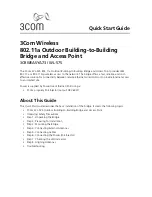
15
DI-724U User’s Manual
D-Link Systems, Inc.
Using the Configuration Menu
SSID Broadcast:
Service Set Identifier (SSID) is the name that identifies a specific
wireless local area network (WLAN). When a wireless device
is browsing for available wireless networks, this is the name
that will appear in the list. For security purposes, it is highly
recommended to change from the preconfigured network name.
You can change the SSID to match an existing wireless network
or create a new name to establish a new wireless network.
Security Mode:
To protect your privacy, use the wireless security mode to con-
figure the wireless security features. This device supports three
wireless security modes including: WEP, WPA-Personal, and
WPA-Enterprise. WEP is the original wireless encryption stan-
dard. WPA provides a higher level of security. WPA-Personal
does not require an authentication server. The WPA-Enterprise
option does require a RADIUS authentication server.
802.11g Only
Mode:
If all of the wireless devices you want to connect with this router
can connect in 802.11g mode, you can improve performance
slightly by enabling this mode. If you want to connect 802.11b
devices to this router, leave this option disabled.
Cipher Type:
The encryption algorithm used to secure the data communication.
TKIP (Temporal Key Integrity Protocol) provides per-packet key
generation and is based on WEP. AES (Advanced Encryption
Standard) is a very secure block based encryption. “TKIP and
AES” is a hybrid mode that allows clients using TKIP as well as
clients using AES.
WPA Mode:
WPA is the older standard; select this option if the clients that will
be used with the router only support the older standard. WPA2 is
the newer implementation of the stronger IEEE 802.11i security
standard. With the “WPA2” option, the router tries WPA2 first, but
falls back to WPA if the client only supports WPA. “WPA2 Only”
mode allows only those clients that support WPA2.
Passphrase:
The pre-shared key is entered as a pass-phrase of up to 63
alphanumeric characters in ASCII (American Standard Code
for Information Interchange) format at both ends of the wireless
connection. This phrase is used to generate session keys that
are unique for each wireless client.
Transmission
Rate:
This allows you to specify the rate at which wireless clients are
allowed to connect to the router at. Default is set to Auto.
















































